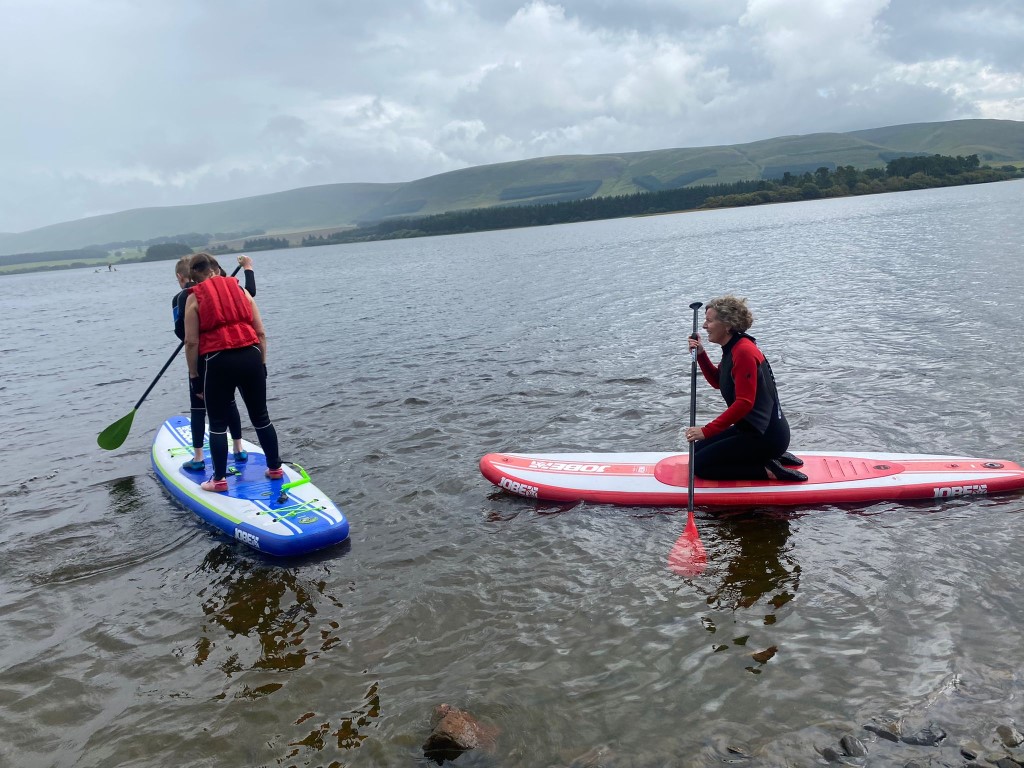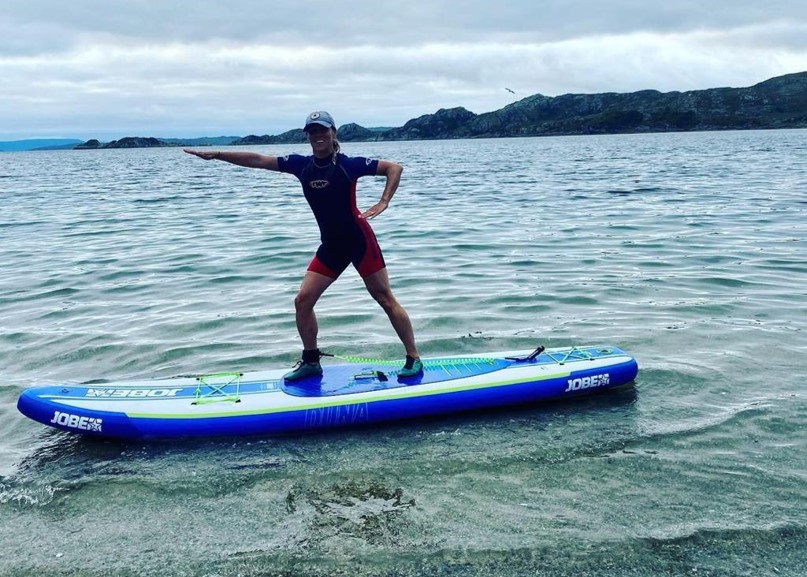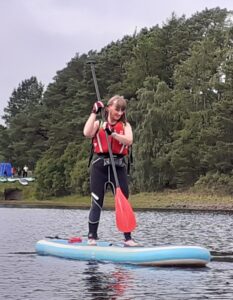When you see someone paddleboarding with ease along the lakeside making it seem effortless, you may be thinking that it takes a lot of professional teaching to reach that level of competency.
The good news is that if you are of average fitness and have a good sense of balance, you can in fact teach yourself to use a paddle board within a day or two.
Yes, it does take time to perfect the art of paddleboarding in different weather or water conditions, reservoir or open water. But the ability to stand or kneel on the board is something that can be achieved by the novice paddleboarder in a very short time.

Balancing on a Paddleboard
Balancing properly on a paddleboard, especially in the standing position, is something that just takes a little practice for most people.
If you have a good core strength, then this is something that can be accomplished even within the first day. However it does take a bit of confidence to begin with – something that many novices lack until they get used to the motion of the water.
To begin with, the idea is just to get on the board. Position yourself dead center in a kneeling position and just feel the motion beneath you.
When you are comfortable kneeling and paddling in this position, then slightly change your kneeling posture just as if you are kneeling at home and about to get up on your feet.
Once you are stable enough, simply rise up in one smooth motion until your are standing firm and evenly spaced on the board. Yes, you may wobble a little to begin with, but after a little practice you will find that you can do this without even thinking about it. This is SUP (Stand up paddleboarding)

Learning to paddleboard on your own is something that can be done for sure – but it is better demonstrated by someone who has paddleboarding experience – and more enjoyable to be sure.
Whilst Paddleboarding can be an ideal way just to be on your own and enjoy nature, I have found that personally it is much more enjoyable to have friends around – especially for a barbeque and glass of something nice at the end of the day!
What about rough weather SUP?
Rough stormy weather is not good for Paddleboarding in general, no matter how skilled (or not) you may be. Learning to paddleboard in the smooth still waters of a glacial lake, does not adequately prepare the novice for daring the elements in rough open water.
Risks associated with inclement conditions would include…
- Windy conditions: This usually means that the wind will lift the water leading to turbulent or choppy conditions, making it difficult to stabilize yourself or even make any headway.
- Offshore winds: This is especially if you are Paddleboarding in open sea or even a large lake – If you are on a paddleboard or even kayak – NEVER go out when the wind is heading offshore into the water. You may well find it impossible to get back to shore if you do.
- River Paddleboarding: Unless you are very confident in your abilities, Paddleboarding on river systems can be risky – especially where there is rough water involved. Fallen trees (or floating lumber) is also something to consider if you are planning a river trip.
Paddle Boarding safety:
- Floatation device: As with any water sport, safety must be your first priority. This means the proper equipment like a good floatation device, as an absolute essential piece of kit.
- Paddleboard Tether: This is what connects you to the board in case you take a tumble – which happens to the best of us on occasion! The last thing you want is to land in the water and watch in despair, as the wind carries away your board into the bright blue yonder!
- Emergency whistle: This is something that many folks on the water fail to acknowledge. The piercing sound of a simple whistle can travel a long distance and could be a real life-saver should you need help – for example if you have just lost your paddle.
- Waterproof bag for mobile phone: This is another important piece of kit. A waterproof bag or purse to keep your mobile phone dry – especially in the case of an emergency.
Are there more things to consider when going out with your Paddleboard? Yes indeed there are, and you can find more paddle board tips for beginners in this article.
Summary:
Paddleboarding is certainly growing massively in popularity, which means that many more people are wondering just how hard it is to try Paddleboarding for the first time.

Like anything else, it is a sport or hobby that will just improve with practice and observation – even if this just means watching others do it until ‘the penny drops’ and your are able to grasp the concept for yourself.
Yes, you can pay for lessons. In fact I would recommend going out with a professional outdoors group at least to begin with. They will help you grow in confidence and teach you some early skills that would otherwise take you longer to learn on your own.
at least to begin with. They will help you grow in confidence and teach you some early skills that would otherwise take you longer to learn on your own.
Failing that – just go for it! I can personally testify that Paddleboarding is quite easy to learn. It is great for your physical and mental health – and it’s great fun!
Check out this post on Paddle Board accessories.
Recent Posts
Our latest Paddleboard adventure comes mainly thanks to driftwoodadventures! They kindly arranged the whole thing for us - which is important to us especially, as we were not sure of the...
What Fitness Level Do I Need For Stand Up Paddleboarding (SUP)?
Stand-Up Paddleboarding (SUP) is a fantastic water sport that has grown significantly in popularity in recent years. It's a fun and accessible activity that allows you to enjoy the outdoors and get...